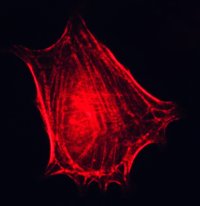Fluorescence Microscope
High-Intensity Light, Dyes and Stains
The fluorescence microscope is the most used microscope in the medical and biological fields.
These types of microscopes use high-powered light waves to provide unique image viewing options that are unavailable with traditional microscopes.

Pictured right: Microscope image of human cancer cell in red fluorescence.
When a specimen can be made to fluoresce studying certain structural properties of the specimen is made easier, either emitting this light naturally or achieved through treating with dyes and stains.
When the light of a specific wavelength irradiates certain specimens they can emit energy seen as visible light.
High Intensity Light
High intensity light is used instead of the standard illumination commonly found in compound microscopes.
Using mercury and xenon arc lamps as high-intensity illumination sources causes a large amount of excitation energy in the specimen providing those details not visible using traditional light.
For the specimen to be viewed sufficiently, image brightness is key and needs to be achieved using the correct wavelength of light. Selecting an efficient barrier filter (available from manufacturers) helps to allow for selected wavelengths of light, those that excite specific fluorophores, to enter the observation eyepiece while correctly blocking others.
The goal is to maximize the amount of emitted fluorescence from the sample being observed, either highly contrasting against a dark background or those that are barely visible.
Dyes and Stains
In the early 1900s, scientists discovered that many biological specimens, when treated with dyes, revealed detailed hidden structures and components. For information on different types and techniques see cell staining in light microscopy.
When minerals were exposed to ultraviolet light, they produced various colors of lights and using UV waves, this technique was applied to biological specimens.
When specimens are stained, more components can be seen and the details of the inner structures of molecules and cells opened up new fields of microscopy.
Microscopic specimens can be stained with fluorochromes, sometimes referred to as fluorophores that attach themselves to very specific structures within cells.
The knowledge gained from using this technique has provided scientists with new tools including some that can manipulate sub-cellular structures.
If you would like to use fluorescent dyes to create a perfectly labeled cell using a fun interactive tool visit invitrogen.com.
Epi-Fluorescence Microscopes
Unlike standard fluorescence instruments, the epi-fluorescence microscope illuminates specimens using a dichroic mirror that separates light waves illuminating different parts of a specimen within certain wavelengths of light.
Many epi-fluorescence microscopes are inverted, meaning that the light source is directed upwards from below the specimen platform.
The dichroic mirror when used with colored filters produces a wide range of image options.
Also of benefit in epi situations are higher magnification dry objectives used where resolution isn't critical as in the measurement of microscopic distance.
More and more computerized filters and digital imaging systems providing high resolution and multiple frames per second imaging are replacing manual turret filters, which can be difficult to use.
Providers
Most of the top microscope manufacturers have at least one of this type of microscope in their lines.
- Nikon - The Ti-E a fully motorized, multimode imaging fluorescence microscope, a component type instrument that provides up to five different viewing ports.
Ti-U offers a range of laser options and Ti-S provides the base instrument for dedicated tasks.
Ti-E and Ti-U component additions include time-lapse imaging with automatic focus correction, phase contrast, automated imaging software and the motorized laser TIRF illuminator. - Olympus - The FSX100 Bio Imaging Navigator has three observation modes including fluorescence, phase contrast and bright field, a variety of imaging options for each mode, self-contained and user friendly.
- Zeiss - The Axiovert 200M is an inverted fluorescence light microscope that is fully motorized and capable of live cell microscopy.
Axiovision software allows multiple view fields, this unit can be equipped with AxioCam, Roper Scientific Cascade 512B EMCCD camera, Mrm or HRC color CCD cameras, and optical sectioning can be performed with this instrument. - Leica - MM AF is a versatile instrument that provides a journaling system allowing research to be standardized by beginner or advanced users. This multi-dimensional instrument can be used for motility study, morphometry and co localization.
The Leica AF6500 fluorescence system provides fast two-dimensional time-lapse capabilities allowing cellular processes to be observed, recorded and analyzed.
The fluorescence microscope provides scientists with the ability to observe very small details and processes that until now were hidden in plain sight.
Read more on immunofluorescence as a technique with a fluorescence microscope and the Green Fluorescent Protein (GFP).
As well as understanding Total Internal Reflection.
To research other techniques available, check out the page on Microscopy imaging techniques.
See immunohistochemistry also.
You can find fluorescence microscopes at Amazon.com by Omax and Amscope manufacturers in particular. Check them out here.
You may find our articles on Photoactivated Localization Microscopy and Wide field Epifluorescence Microscopy interesting too.
Return from Fluorescence Microscope to Compound Light Microscope
Return to Best Microscope Home
Find out how to advertise on MicroscopeMaster!




